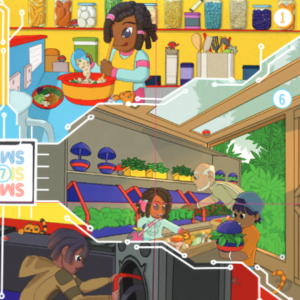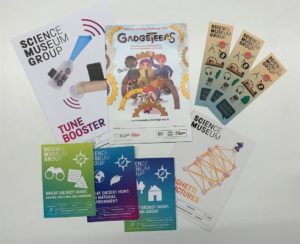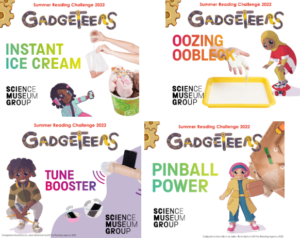The Summer Reading Challenge is delivered in public libraries every year and encourages over 70,000 children across the UK to read during the summer holidays.
Partnering with the Challenge this year was a great opportunity to reach an audience we’ve never reached before – an audience who might not have visited our museums, who may not feel confident in STEM (science, technology, engineering and maths) or who believe that STEM isn’t for them.
On signing up to the Challenge, participants received a poster introducing the six Gadgeteer characters. Each Gadgeteer had a particular interest (e.g. music) and a “super science skill” (e.g. communication).
Throughout the summer, participants had the chance to collect rewards featuring the characters and could also find out more about these interests through links to related resources and activities.
The chance to create, curate and support the development of some of these resources (alongside the Reading Agency) for those taking part in the Summer Reading Challenge, whether in libraries or at home, allowed us to reflect on how best to engage and inspire this new audience, igniting their curiosity around STEM.
science is all around us
Our work has shown that many people see science as something abstract with little impact on their everyday lives. As part of the Challenge, we wanted to address this by highlighting that science and technology can be found in everything we do.
One way we looked at this was by working with the Reading Agency to help decide the main STEM links to the ‘interest areas’ of the Gadgeteers. We wanted to help people recognise that science isn’t just a subject learnt at school but can be found in many of their favourite things, like music, fashion or sport.
We made suggestions for some of the featured science ideas, in particular things that people could do in their own lives – like making oobleck or growing plants without soil – rather than having all the ideas be futuristic and therefore (potentially) abstract.

We were also keen that not all the characters were inventors tinkering away creating machines. There’s a risk this could have perpetuated the stereotype that science is only for ‘smart’ people with the ability to design and build new things.
Instead, it was important for us to highlight that science and technology isn’t just about inventing but also about using the skills that we all have, such as curiosity, imagination and problem-solving, in order to explore and try out new things.
As well as the poster, we had the opportunity to explore these topics in more detail in the Gadgeteers Area Cards created to help people find out more about the science and innovation in these areas.
This included, for example, demonstrating how cooking involves scientific and mathematical skills, or how you can problem-solve to improve something you use every day, so it works even better. These are things that everyone can do – just by asking a question to find out more you’re using scientific skills.
Working with the Reading Agency meant we were also able to suggest links to existing Science Museum Group resources. Those taking part in the Challenge – if they wanted to find out more – could follow their curiosity and extend their learning through a range of relevant activities designed to help explore and discover STEM in fun and exciting ways.
what’s in a name?
Although we have lots of learning resources available on our website – over 140 – this was a good opportunity to recognise the way they’re presented might not always be the most helpful for informal audiences.
In order to support the Challenge, we decided to curate a new Community Science webpage. This was designed as somewhere that librarians, community groups and families (and anyone else taking part) could be directed to in order to find out more and continue exploring.
In creating this page, as with everything we do, it was essential to put the audience at the heart of the process. This meant considering the question, ‘Will the audience know what we mean by a resource?’
Although a familiar term to teachers and museum professionals, we recognised that perhaps we needed to use more relatable language for this audience and decided that saying ‘activities’ was more helpful.
We also wanted to address the fact that visitors to this webpage joining us from the Summer Reading Challenge might want to find out more, but also might be lacking confidence in STEM.
As well as bringing together a selection of exciting resources with strong links to the Challenge, our aim was to ensure they were supported by useful information, ideas and top tips.
This included:
- Reassuring people it’s OK if they don’t know all the answers. We recognise that STEM subjects can cause anxiety, so highlighted that science isn’t all about content, but rather about encouraging curiosity and using your imagination to explore the world around you.
- Promoting confidence in using the resources however they want! Although we design our resources to be as fun and useful as possible, they don’t need to be used prescriptively. We emphasised that people can be creative with them – whether trying out different materials or using the resources to inspire their own ideas.
We also created a webinar to provides tips and techniques on how to inspire and engage people in science through reading – see my colleague Jess’ blog for more information.
Reflection
Within the Science Museum Group (SMG) we have engagement reflection points which help us think critically about our audiences’ experience. We used these when creating and supporting the development of these resources. The three I found particularly helpful were:
- Use everyday examples. For us, it was important that not all the characters were making brand new inventions. We wanted some of the Gadgeteers to carry out activities that people could also try themselves.
- Highlight and develop skills. Although each Gadgeteer had a “super skill”, we emphasised that everyone has and uses a wide range of STEM skills in their everyday lives – and it’s important to name them so people recognise these skills.
- Extend the experience. Those taking part in the Challenge could continue exploring STEM, whether following links to our resources or being inspired by the theme to read books featuring STEM topics.

It was amazing having the chance to work on the Summer Reading Challenge and we hope that by reflecting on how to effectively engage this new audience that we’ve helped more people feel they can do and be a part of STEM.
WHAT TO READ NEXT
- Supporting library communities with the summer reading challenge
- How to extend classroom activities into the home
- Science engagement tool: Using everyday examples
The Gadgeteers Summer Reading Challenge ran across the UK from June to September 2022. If you took part and used any of our resources, we’d love to hear your thoughts in the comments.